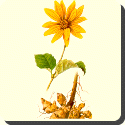 Jerusalem Artichoke — The Jerusalem artichoke (Helianthus tuberosus), also called the sunroot or sunchoke or topinambur, is a species of sunflower native to eastern North America, from Maine west to North Dakota, and south to northern Florida and Texas. It is also cultivated widely across the temperate world for its tuber, which is used as a root vegetable.
Jerusalem Artichoke — The Jerusalem artichoke (Helianthus tuberosus), also called the sunroot or sunchoke or topinambur, is a species of sunflower native to eastern North America, from Maine west to North Dakota, and south to northern Florida and Texas. It is also cultivated widely across the temperate world for its tuber, which is used as a root vegetable.
It is a herbaceous perennial plant growing to 1.5–3 m tall. the leaves are opposite on the lower part of the stem, alternate higher up; the larger leaves on the lower stem are broad ovoid-acute and can be up to 30 cm long, the higher leaves smaller and narrower; they have a rough, hairy texture. The flowers are yellow, produced in flowerheads 5–10 cm diameter, with 10–20 ray florets. The tubers are gnarly and uneven, typically 7.5–10 cm long and 3–5 cm thick, and vaguely resembling ginger root, with a crisp texture when raw; they vary in color from pale brown to white, red or purple.
Unlike most tubers, but in common with other members of the Asteraceae (including the artichoke), the tubers store the carbohydrate inulin (not to be confused with insulin) instead of starch. For this reason, Jerusalem artichoke tubers are an important source of fructose for industry. The crop yields are high, typically 16–20 tonnes/ha for tubers, and 18–28 tonnes/ha green weight for foliage. Jerusalem artichoke also has a great deal of unused potential as a producer of ethanol for fuel, using inulin-adapted strains of yeast for fermentation.
Jerusalem artichokes are easy to cultivate, which tempts gardeners to simply leave them completely alone to grow. However the quality of the edible tubers degrades unless the plants are dug up and replanted in fertile soil. This can be a chore, as even a small piece of tuber will grow if left in the ground, making the hardy plant a potential weed.
 Kids Portal For Parents India Kids Network
Kids Portal For Parents India Kids Network






